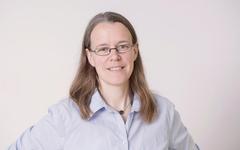Kerstin Tackmann. Bild: DESY
DESY scientist Kerstin Tackmann strengthens the particle physics department at DESY: she follows a call by the University of Hamburg to become a W3 professor and at the same time becomes a lead scientist at DESY.
Kerstin Tackmann has already done research in various experiments and has already had a steep science career trajectory. She studied physics at TU Dresden and received her PhD at the University of California Berkeley in 2008 as a researcher at the BABAR experiment at the SLAC National Accelerator Laboratory in the USA. After completing her doctorate, she went to CERN in Switzerland as a Research Fellow to become an expert in Higgs physics at the ATLAS experiment. Her special focus is on collisions in which a Higgs particle decays into two photons. Reconstructing and identifying these photons from the data poses a particular challenge.
In 2011, Tackmann came to DESY to head a Helmholtz Young Investigator Group. Since 2016, thanks to an ERC Starting Grant endowed with 1.3 million euros, she has been leading a working group at DESY to investigate the characteristics of the Higgs particle in order to determine whether or not the particle fits the predictions of the Standard Model of Particle Physics.
As Lead Scientist, she will continue to study the Higgs boson in detail at the ATLAS experiment. “We still have a lot to do," she says. "In the near future we will be working on differential cross section measurements as part of the ERC project. In addition, I am Higgs convener until the end of September 2019, which means I head the Higgs working group within the international ATLAS research collaboration." On top of these projects, she returns to topics from her doctoral thesis and starts measuring CKM matrix elements in inclusive B meson decays in the Belle2 experiment at the Japanese KEK research centre. The CKM matrix describes the mixing of the different quark flavours.








